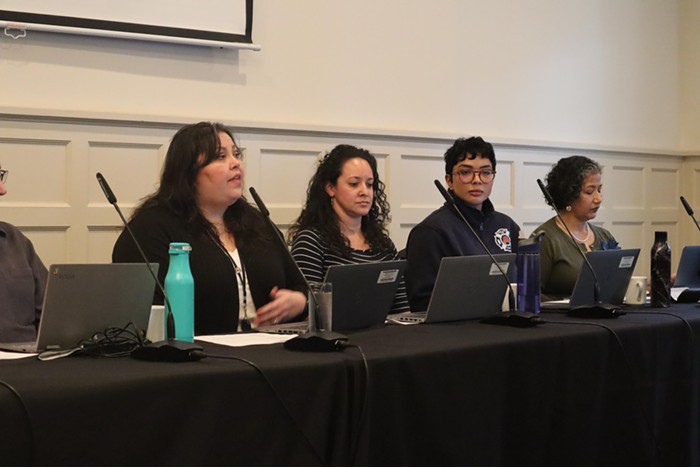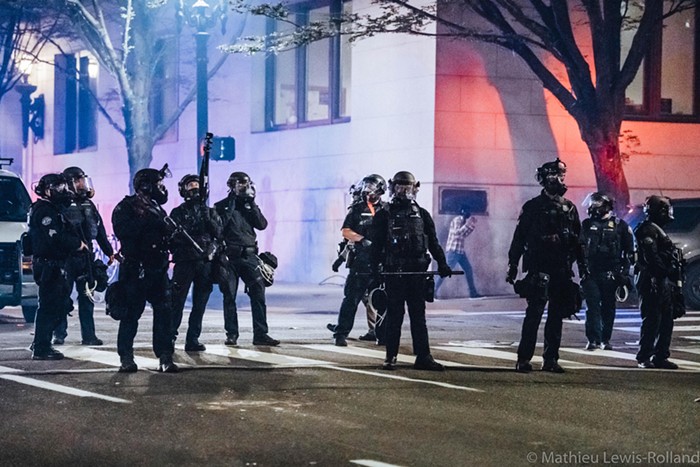The kitchen smells odd, and you open the oven, which has been cranked to a broiling 500 degrees. You're looking for a ready-made casserole or perhaps a pan of chicken breasts. Instead, you discover your kitten, baked alive. Following this surprising discovery, you turn around to find yet another surprise: Your husband is holding a jump rope, and he begins choking you.
A desire to isolate the woman from her support system is another important and more subversive trait of the abusive and potentially homicidal partner.
The previous testimony is from a domestic abuse case in Ohio. If it seems like every day another woman is dying at the hands of a husband or boyfriend--they are.
On July 9, in Pendleton, OR, a jealous ex-lover sat and waited for Renee Melendrez, a mother of three, outside her job. When she arrived at work, he shot her to death before turning the gun on himself. On June 28, after being tipped off by a concerned neighbor, the Portland police investigated a domestic disturbance call involving Juliet Miller and her husband. A few hours after the police left, Miller was found strangled to death.
In the last year, some of the most visible news stories have also been the most gory, featuring men described by acquaintances as "the nicest guy" slaughtering their wives and children. Less newsworthy, but just as alarming, are the 3,000 women killed (not to mention the thousands upon thousands of women who are beaten) by their partners or ex-partners--battered, strangled, or murdered, because a man's compulsion to dominate spirals out of control.
STATISTICS
Because of the private nature of domestic violence, few people are aware of the severity of the problem in the United States. In Portland alone, 7,025 reports of domestic violence were made to the police in 2001; these numbers exclude the thousands of incidents that went unreported.
According to the American Psychological Association, violence against women occurs in 20-30 percent of dating couples, and the American Medical Association reports that 20-30 percent of ambulatory care patients are battered women. Equally disturbing are reports (from the Psychiatric Times) that one in three women who attempt suicide does so because she is battered--and battering is thought to be the "single most important cause of female suicide in black and pregnant women," according to a 1995 study.
THE CHARACTERISTICS OF A KILLER
Nancy Glass, an assistant professor at the OHSU School of Nursing, participated in a national research project designed to identify the risk factors for intimate partner homicide. During the study, researchers spoke with women who had been brutally attacked by their husbands or partners, and families of women who had been murdered by their partners. Using a questionnaire labeled "Danger Assessment," they were able to determine a number of factors which, when combined, put women at a increased risk of being killed by their intimate partners.
Glass summarized the dangerous traits, saying, "Is he unemployed, controlling, or jealous, or does he say that 'no other man would want you'? We're concerned about men who use drugs and alcohol, especially men who are violent and using. We're concerned about men who are suicidal or threaten to kill the children If there is a child in the home, and the man is a stepfather, it increases the wife's chance of being murdered."
"Depressed men are dangerous because their [world] view is not rational," Glass continues. "Depression skews their decision-making, and how they think of the future. We're also concerned about men who have access to guns. Guns in the home always increase the risk of being murdered. Unemployed, access to a gun, threatens to kill her, non-biological child in the home, threatens suicide these are very dangerous men."
"Women want to look the other way--saying he's depressed, jealous, likes to hunt--but I have a very different perspective on these things," Glass says.
THE ISOLATION FACTOR
A desire to isolate the woman from her support system is another important and more subversive trait of the abusive and potentially homicidal partner. In the Christian Longo case, he murdered his wife and three children, dumping their bodies in the ocean off the Oregon coast. While the youngest child was strangled along with his wife, Maryjane, his two other children drowned. Prior to the tragedy, Longo had been kicked out of the local Jehovah's Witness congregation for breaking the law. He then uprooted his family from their home, family, and friends in Michigan, to avoid prosecution.
Because of Longo's need to run, Maryjane was taken away from her church, job, parents, and--in effect--any support system or reality check. The Longo family (and especially the sheltered wife) was secluded from any helpful intervention. By the time Maryjane's family went in search of them at their last known residence in Toledo, the Longos were long gone to Oregon, and soon after, dead.
Similar is the case of the Bryant family, from McMinnville, Oregon. Not only did they belong to the Jehovah's Witnesses, they were also ousted from their community because of problems pertaining to the husband. When Robert Bryant had a disagreement with his congregation and went bankrupt, he moved to Oregon--much like the Longos--in order to get a fresh start. Even after living in the town almost a year, the family had no friends and didn't allow their children to play with other kids in the neighborhood. No one knew what was going on in the house, or between the husband and wife.
According to the Sacramento Bee, they were described by a neighbor as "a family that wanted to keep their kids close," who "didn't want to expose them to outside influences of any kind." After the husband shot his wife, four kids, and then himself, their bodies remained on the floor of their trailer for three weeks. The family was finally discovered when a neighbor alerted a police officer to the fact he hadn't seen any activity around the house.
According to researcher Nancy Glass, "[The Bryants] were very isolated from other communities, so it was difficult for anyone to know how serious the situation had become."
"Isolation is a strategy used by the abuser," she continues. "Women will think, 'He loves me, he wants to spend time with me.' Then he'll start insulting her family and friends, and soon, she's isolated from her support system. They're very manipulative and charming in systematically separating the women. They know what they're doing. They want the woman to depend on them solely, and they want control."
TO PROTECT AND SERVE?
Not only is the epidemic of violence against women enormous, violence occurs at an even higher rate in the homes of society's supposed protectors--the police. Numbers from two separate studies indicate that abuse occurs in at least 40 percent of police officers' families, as opposed to a 10 percent rate of families in the general population. This means that wives of police officers who are beaten are further oppressed by the fear that their call for help will be answered by the husband's coworkers. And, most likely, a batterer who responds to a domestic violence call will be less sympathetic if he himself is a batterer.
The indifferent attitude with which the police meet abusers can be considered a metaphor for the way society accepts and ignores spousal and partner abuse. According to Glass, this is because "our society hasn't decided that we don't want men to abuse women. Women are still seen as property. People seem to think it's okay for a woman to be killed if she's leaving the man for someone else. I mean, he caught her in bed with someone else, of course she should be killed. It's not seen as a criminal issue, more of an issue that should be solved in the home."
According to the National Center for Women and Policing, "most [law enforcement] departments across the country typically handle cases of police family violence informally--often without an official report, investigation, or even check of the victim's safety."
They go on to say, "A recent study of the D.C. Metropolitan Police Department found inconsistent policies and practices for officers accused of domestic violence, regarding arrests, seizure of firearms, and Employee Assistance treatment. There is no reason to believe that the D.C. Metropolitan Police Department is unique in this; rather, this inconsistency is typical for police agencies responding to domestic violence committed by it's own members."
Furthermore, in a study by the Southwestern Law Enforcement Institute, "only 19 percent of [police] departments indicated that officers would be terminated after a second sustained allegation of domestic violence." Police officers also fit into the offender profile provided by Glass, as most of these men have guns in their home.
In June of 2002, Mario Carlos Jackson of the Denver Sheriff's Office was arrested for four attacks on his wife, during which he beat her with a belt, struck her in the head, choked her, raped her, and threatened to kill her. Yet he was only charged with misdemeanor domestic violence and assault, released on $2,500 bond, and given paid administrative leave.
A 1997 study of the Los Angeles Police Department by the Domestic Violence Task Force examined 91 cases in which an allegation was brought against an officer for domestic violence. According to their findings, in 75 percent of the cases, the allegation was not mentioned on the officer's performance report. 26 of the officers were promoted; six of them within two years of their violation. Most were allowed to continue investigating domestic abuse calls.
THE OTHER SIDE OF THE LAW
Attempting to prosecute an abuser can be tricky. Often times, there is little to no evidence of violence, and even if the abuser has been battering for years, there are no witnesses.
Chiquita Rollins, Multnomah County Domestic Violence Coordinator, says, "There are problems with the law. The law is bad at looking at patterns. You have an incident where a man hits a woman, the DA looks at that as one assault--not 10 years of abuse. The incident may not be terrible, but in the context of a long period of abuse, it is. Choking is a big red flag, but as soon as he lets go, there is very little evidence."
Conversely, the reluctance of women to press charges is another huge problem for prosecutors. Often times, the woman loves the batterer, and/or is financially dependent on him, therefore doesn't want him to go to jail. In fact, women in low-income brackets are more likely to stay with their abusers because they're unable to see an alternative.
Stacey Heyworth, Sr. Deputy in the Domestic Violence Unit at the District Attorney's office, says, "One of the big problems is having victims show up for court. People have psychological and economic issues that keep them with the offender. It's a huge obstacle for the victim. Often times, they either don't show up for court, or show up and don't want to tell what happened."
On average, a battered woman will return to her partner seven times before leaving for good, so there's an obvious battle between her desire to stop the abuse, and her connection to the abuser.
Fawn Guston, a staff member at the Bradley-Angle House--a shelter and support group center in Portland--says that each time a woman leaves her abuser, she learns something and starts planning. She recounted the story of one woman who stayed with her abuser for four years while saving enough money to support her children and go back to school after leaving him.
In Oregon, there is a Domestic Violence Law that requires the police to arrest the offender if there are signs the victim has been struck. Before the law, Police Spokesperson Henry Groepper says, the woman would have to answer the question, "Do you want him arrested?" in front of her batterer--which, for women in a love/hate relationship, is extremely difficult to answer.
In the previously mentioned case of Juliet Miller, the police were called after the wife was seen damaging her own car outside her apartment complex. According to Groepper, when the police arrived, the Domestic Violence law was irrelevant because there were no signs of injury, and the couple did not want the police around. Several hours later, a call came in informing the police that there was a woman in the apartment who was possibly dead. When the police arrived, Juliet Miller had been strangled to death.
SOMEONE YOU KNOW
While domestic violence runs rampant, the solutions are vague. At the Bradley-Angle house, support groups teach women to recognize the dynamics of domestic violence, and the notion that women deserve to be safe. But just getting a woman to the support group is often an obstacle. Once there, women in battering situations are assisted in coming up with a "Safety Plan," in case the abuse escalates to a crisis situation.
"If he escalates into violence," Chiquita Rollins says, "she may need to go someplace where he can't find her. Sometimes she can't tell her family or friends. He may trace what she's looked at on the internet. Leaving is not 'I'm going to go find a new apartment.'"
As for intervention from friends or family, it's often difficult for outside parties to get involved, because they may be unaware or ignore the abuse--especially since it takes place behind closed doors, and the batterer may be a very different person in public.
"People who abuse might be your brother," says Rollins. "They can be very charming and gregarious. A very high proportion of abusers will only assault their partner, and only in private. It's often very hard for people to believe that the abuser could do these things."
Education and rehabilitation are also of ambiguous help. Fifty percent of batterers drop out of intervention groups, and those who stay have to be committed to the program--which isn't easy when batterers face little to no consequences for their actions.
Rollins says, "If you look at bullying information, it's not just about educating the bully and the victim, it's about intervening. You can't just tell them [it's wrong to hit]. There's an old saying: Abusers abuse because they can."
Bradley-Angle House Crisis Line: 281-2422


















